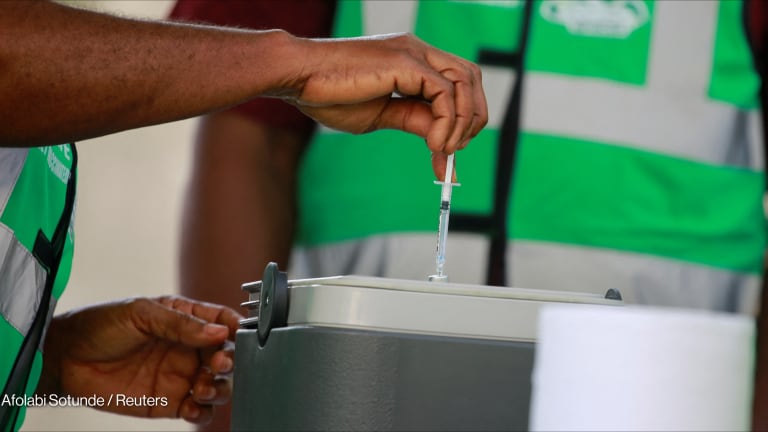
Recent health trends have shown that emerging infectious diseases are unpredictable and challenge health authorities’ abilities to control them. However, we continue to build meaningful capacity to tackle these emerging infectious diseases by concurrently tackling neglected endemic diseases such as rabies. Approximately 45% of worldwide rabies deaths occur in Asia, with more than 1.4 billion people in Southeast Asia at risk of rabies infection. Until we recognize and respond to the interdependence of human, animal, and environmental health, we are setting ourselves back in the face of future pandemics.
What lessons have we learned from implementing a holistic approach to rabies that might better prepare us for emerging infectious diseases?
An integrated approach to managing rabies
The Pro read:
Q&A: What it will take to prevent another virus 'spillover'
What's better than containing a disease outbreak? Preventing it in the first place. Devex speaks to Dr. Aaron Bernstein, chair of the Scientific Task Force to Prevent Pandemics at the Source, about a new report on how to do that.
Today we celebrate the 16th World Rabies Day with the theme “Rabies: One health, zero deaths.” From the global rabies community’s work toward rabies elimination, we have seen a transdisciplinary alignment that includes the involvement of non-health sectors such as local governments, education institutions, NGOs, and the animal health and tourism industry.
While this is not prevalent in many affected countries, when an integrated approach with collaboration and capability building is taken, we have seen progress.
Collaboration
The first important lesson is the need for strategic collaborations, globally and locally. In 2018, the World Health Organization, the Food and Agricultural Organization, the World Organisation for Animal Health, and the Global Alliance for Rabies Control joined forces in a partnership called United Against Rabies to establish clear objectives for affected countries and key stakeholders.
These objectives include the effective use of vaccines, medicines, and technologies that prevent dog rabies transmission and reduce the risk of human rabies deaths, the use of evidence-based data to measure impact and inform policy decisions, and harnessing multistakeholder engagement for commitment and resources.
The pharmaceutical industry plays a vital role in dog vaccination as it protects dogs, other animals, and people in the community from rabies, demonstrating its holistic impact on human health. Moreover, it is about 50 times cheaper than providing post-exposure prophylaxis to people and is a sustainable way to prevent human rabies deaths.
Across the region, Boehringer Ingelheim works closely with veterinarians, pet owners, NGOs, and health authorities to help control the spread of rabies. Together with GARC, we aim to vaccinate 12,000 dogs and cats across Indonesia, Malaysia, the Philippines, and Vietnam in 2022 alone.
In Vietnam’s Long An province, a partnership between a university, private sector companies, local administration, and the community has achieved the vaccination of more than 6,000 dogs and cats in 11 villages.
Engaging local partners also allows us to educate community members on the importance of protecting oneself and on pet vaccination.
Capacity building and localized strategies
Another key lesson has been supporting local capacity building and planning. We must apply dedicated localized strategies to succeed in sustainable rabies elimination in Southeast Asia.
GARC has been providing capacity-building support to many countries under its regional networks. This included working with the local and national governments in the Philippines to set up comprehensive model rabies elimination programs, incorporating rabies prevention into the education curriculum, increasing awareness across the country, and improving surveillance measures. It also supports different local stakeholders across more than seven Asian countries with its tools, resources, and technical support.
As we face increasingly complex infectious disease outbreaks, it is imperative to continue this critical capacity building so that local experts are best equipped to respond.
Capturing reliable data through innovation
Finally, harnessing innovation to capture reliable surveillance data is critical. The Rabies Vaccination Tracker, which allows campaign teams to direct the campaign in real-time, has been used in Indonesia, Malaysia, the Philippines, and Vietnam.
It maps progress, tracks vaccination teams, identifies missed areas, and ensures that the vital 70% vaccination coverage is reached in the affected area. Evidently from the RVT, nearly 7,000 animals have already been vaccinated.
Such innovation in surveillance is essential to drive the success of vaccination campaigns and preempt any future outbreaks — something to replicate across other disease areas.
In our journey to reach the goal of eliminating dog-mediated human rabies deaths by 2030, we have learned crucial lessons that can benefit those working across other infectious diseases. With future emerging pandemics, there is an urgent need to unite like-minded partners toward a common goal. We need to keep sharing our learnings to ensure that we are best equipped to deal with other emerging health crises.






